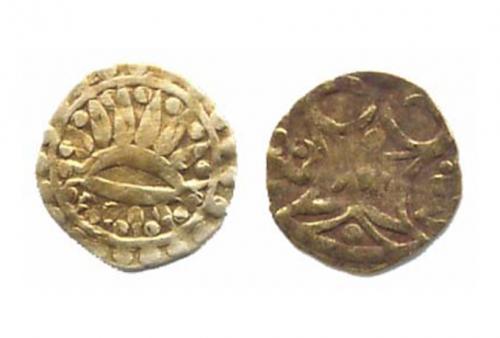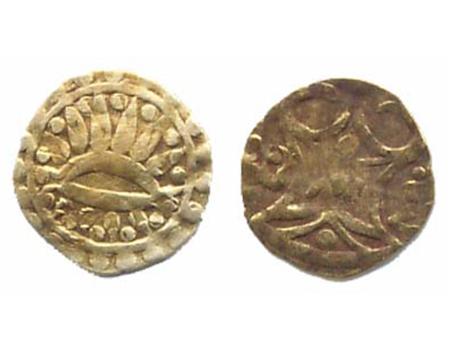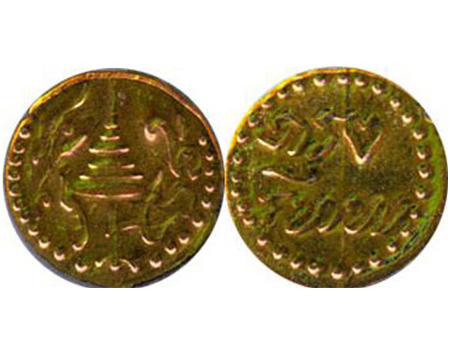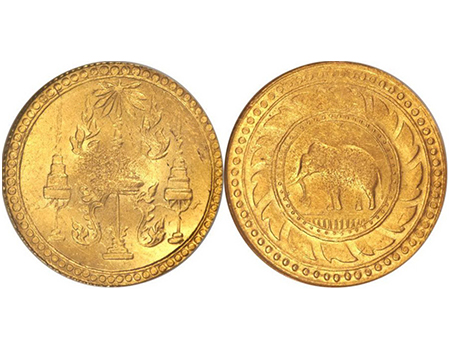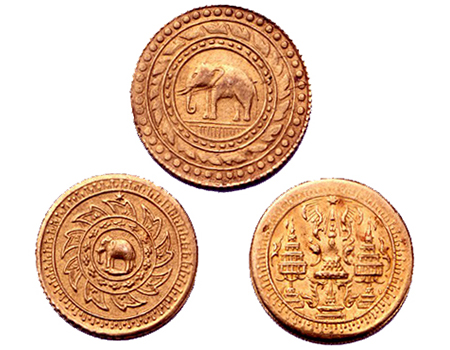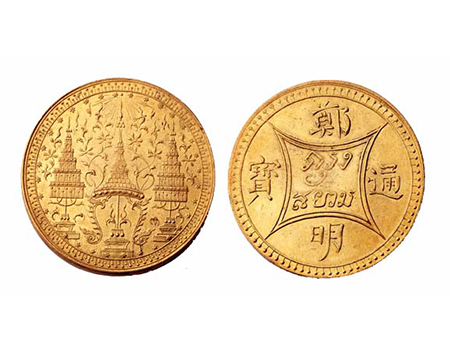By S. Wattanalumleard
Men has been aware of the value of gold since ancient times and various types of ornaments, decorations, utensils and money made of gold have been found in many areas throughout the world. Some of these items are more than a thousand years old. The fact that gold became of interest to mankind is simple. Apart from its beauty, gold is among the most durable metals on Earth as it does not corrode, tarnish or change its form overtime, in fact, it is one of the rarest of the high value metals because of it's very limited supply. These qualities make gold the most significant metal of all time.
The history of gold in coinage began around 550 BC. It is recorded that the ancient kingdom of Lydia, which is now Turkey, first produced their own money from gold. The money is usually referred to as starter of Croesus (Croesus: the King of Lydia 561-546 B.C.). It is in a category of electrum coinage which is an alloy of gold and silver. Ever since then, gold coins have been an important medium for commercial transactions and have been selected for minting the highest denomination and most valuable coins in every country.
As for Thailand, gold is a very rare metal and as such, most coins in the old days were struck from gold, gold ornaments and general utensils brought in from overseas merchants. Even then, gold coins were only struck only in the kingdom once the economy became prosperous.
gold ornaments and general utensils brought in from overseas merchants.
The first known use of gold in the production of Thai coins was in the Dvaravadhi era (6th - 11th Century A.D.). Past research has revealed that the kingdom traded with India, China, Arabia and Persia as long ago as that and the people of the Dvaravadhi era made their own money to be used for commercial exchange in foreign trades. The gold coins of the Dvaravadhi era bear on the obverse, the conch shell, which is a symbol used in Buddhism.
Down in the south of Thailand to the Malay Peninsula and the South Sea Islands around the same era of Dvaravadhi was situated the kingdom of Srivijaya. Coinage from this kingdom implied a strong influence from the Phoenicians. There is evidence that the ancient coins of Lydia that were found in this area were brought in by Phoenician merchants. However, the Srivijayans struck their own money from silver and gold. Their money was round in shape, ranging form 9 to 12 millimeters in diameter and on one side of the coin it has the ancient sanskrit characters vara meaning sublime. This type of money is called dokchandra or sandalwood flower money. Another coin made of both gold and silver was namo money. The coin bore sanskrit characters na on one side. However, this money was usually regarded as amulets orrather than as money.
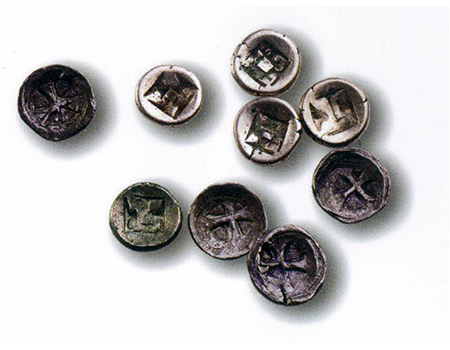
This type of money is called dokchandra or sandalwood flower money.
The Srivijaya kingdom declined in the 14th century and later became a vassal state under the Ayudhaya kingdom (1350 - 1767). During this period, Pattani, one of the cities in the south of Thailand, had become a main seaport and a center of foreign trade. This city had their own money called kupand. The coins were made of gold and with a weight of around 0.65 to 7 grams and a diameter of 10mm. The coins were made by stamping marks on both sides and trimmed around the edges to get the correct weight. There were 3 different types of kupand coins namely; cow coins, sun coins and jawi inscription coins. They were minted for the purpose of trade and also for payment of tax to Sultans.
cow coins, sun coins and jawi inscription coins.
The Ayudhaya kingdom (1350 - 1767) produced gold pod duang or bullet money which was to be used throughout the kingdom. As a major trading kingdom with other countries, Ayudhaya was abundant with gold which came pouring into the kingdom from overseas merchants. It is assumed that many gold pod duang were made during the Ayudhaya period but only a few remain. It is possible that when the city was seized by Burma, many of the gold pod daung were melted down and used to serve other purposes. However, the gold pod daung which have been found bore the kanok or conch shell marks and have the value of 2 Pai.
gold pod duang or bullet money which was to be used throughout the kingdom.
During the Rattanakosin period, Siam opened up for more foreign trade. Many more gold pod duang were produced between the reign of King Rama III and King Rama IV. These more modern flat gold coins were first introduced in the reign of King Rama IV. In 1856, a gold coin of half feung (1 saleung) was struck using a method called the hand-hammering method, which used a device employed to strike coins by marking a sheet of metal and then cutting them into a round shape before stamping the marks on the coin. The coin bore the chakra, the great crown and phra tao. In the same year, gold saleung and feung coins were also struck. This coin showed the great crown on one side and the inscription krung thep on the other side.
This coin showed the great crown on one side and the inscription krung thep on the other side.
When the first minting machine was sent from England as a gift from Queen Victoria, another gold coin was minted and in 1858 the coin 1 patdeung was produced and is called bannakarn. It shows the great crown on one side and an elephant on the other. In 1860, another gold coin of 1 patdeung was released bearing a similar design to the former one. This coin was minted from a minting machine which had been bought from England.
This coin was minted from a minting machine which had been bought from England.
A series of gold coins were issued in 1863, comprising of gold coins consisting of half a feung, half a saleung, half a baht, baht and half a tamleung. The coins also show the great crown and an elephant in the chakra.
In the same year, another series of gold coins were issued, this time in the value of patdeung, pis and tos. The coins show the great crown on one side and an elephant in chakra on the other.
value of patdeung, pis and tos. The coins show the great crown on one side and an elephant in chakra on the other.
However, the most remarkable gold coins of all time are the gold coins with a value of 4 baht which were produced in 1864 showing the great crown on the obverse with the inscription krung siam and in the frame in the center surrounded by chinese characters which reads tae- meng-tong-pao. The word tae-meang refers to King Rama IV’s name and tong-pao meaning money. The coin weighs 60 - 77 grams and has a diameter of 45mm. The coin is said to be the most sought after coin by collectors and is believed to be the most valuable of all Thai coins.
The coin is said to be the most sought after coin by collectors and is believed to be the most valuable of all Thai coins.
It can be said that gold was so plentiful in the reign of King Rama IV that it could be widely used as a medium of exchange in commercial transactions. It was even used to replace the baht in paying salaries to members of the royal family and government officials and was also acceptable for paying taxes.
Gold coins in the reign of King Rama V were first struck in 1876 with a one feung coin bearing the effigy of King Rama V and the state coat of arms. In 1987, a series of patdeung, pis and tos were also released. This series was a replica of a series previously issued during a former reign.
In this reign, the Gold Act of 2451 (1908) was issued to define the value of the baht in terms of pure gold. Ever since, gold has become part of the country’s reserve currency.
During the reign of King Rama VI, there were the minting of specimen gold coins with a value of 1 saleung, 2 saleung and 1 baht in 1913, 1920 and 1921. After this time, the minting of gold coinage ceased for many years due to the world's economic recession and the two world wars. However, the minting of gold coins has resumed in the present reign, under King Rama IX.

the minting of specimen gold coins with a value of 1 saleung, 2 saleung and 1 baht in 1913
The reign of King Rama IX has seen a great variety and different types of coins being issued both for general circulation and for commemorative issues. The first gold coin during this reign was struck in 1968 to mark the 35th birthday anniversary of H.M. Queen Sirikit. After that event, many gold coins have been minted to mark various important occasions. In 1982, Thailand first undertook the striking of proof gold coins to commemorate the Rattanakosin bicentennial celebrations.
Apart from commemorative coins, many gold commemorative medals have also been minted but mostly in proof and uncirculated quality.
References
Bank of Thailand museum, Gold Currency in Thailand, Bangkok, 1996
Martin Jessop Price, the Hamlyn Publishing Group Limited, Hong Kong, 1980
Navarat Laekhakul in Thai Money, The Print International, Bangkok 1991
Treasury Department, Coinage of Rattanakosin, United Producing, 1982
